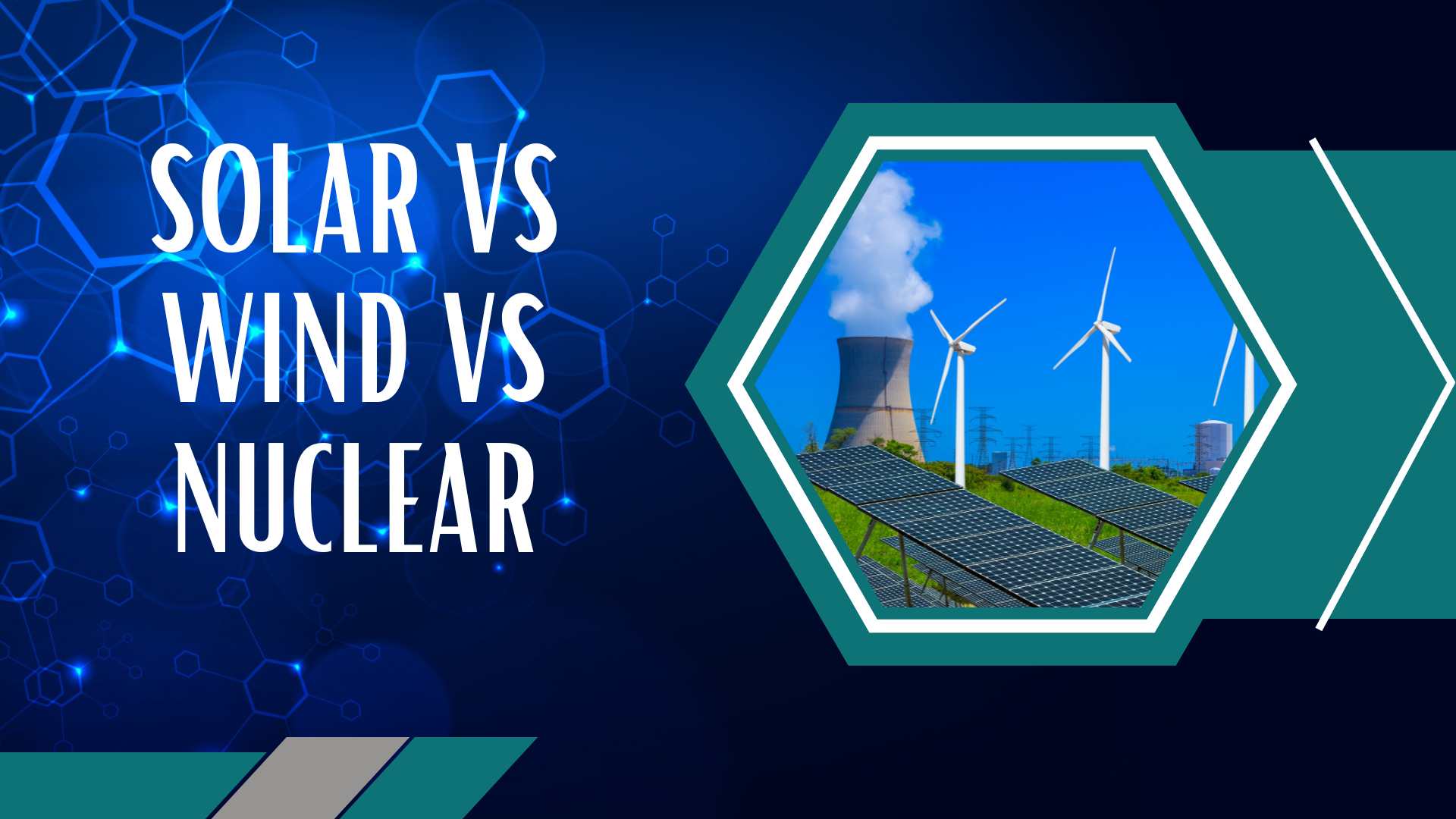Solar vs Wind vs Nuclear
As the world strives towards a sustainable and decarbonized future, the choice of energy sources becomes increasingly crucial.
Let’s delve into the merits and drawbacks of three prominent contenders: solar energy, wind energy, and nuclear energy. By examining their potential, technological advancements, environmental impact, and economic feasibility, we aim to shed light on the future prospects of these energy sources.
Solar Energy:
Solar energy harnesses the power of the sun to generate electricity. It is done through photovoltaic (PV) panels or concentrated solar power (CSP) systems. With abundant solar irradiation reaching the Earth’s surface, solar energy has the potential to be a significant player in the energy transition.
Advantages:
- Renewable and abundant source: The sun provides an inexhaustible supply of energy.
- Low environmental impact: Solar energy production produces no direct emissions, contributing to mitigating climate change.
- Distributed generation: Solar panels can be installed on rooftops, enabling localized power generation and reducing transmission losses.
Challenges:
- Intermittency: Solar energy generation depends on sunlight availability. Making it intermittent and requiring energy storage systems for consistent power supply.
- Land and resource requirements: Large-scale solar installations need significant land area and raw materials, potentially posing environmental concerns.
- Cost and efficiency: Although costs have decreased, initial installation and maintenance expenses remain high. Solar panel efficiency still needs improvement to maximize energy conversion.
Wind Energy:
Wind energy captures the kinetic energy of moving air and converts it into electricity using wind turbines. With vast wind resources across the globe, wind power has gained traction as a clean energy alternative.
Advantages:
- Abundant and scalable: Wind is an abundant resource, and wind farms can be expanded to meet increasing energy demands.
- Emission-free electricity: Wind power generation does not emit greenhouse gases or pollutants during operation.
- Technological advancements: Enhanced turbine designs and offshore wind farms have increased efficiency and energy production potential.
Challenges:
- Variable output: Wind energy is subject to natural fluctuations and depends on wind speed. Making it less reliable without storage or complementary energy sources.
- Visual and noise impact: Wind turbines can be visually intrusive and generate low-frequency noise, potentially affecting local communities.
- Limited siting options: Optimal wind conditions are often found in remote or offshore areas, necessitating transmission infrastructure development.
Nuclear Energy:
Nuclear energy harnesses the energy released during nuclear reactions, typically in the form of fission. Despite its controversial nature, nuclear power offers a potent and reliable energy source.
Advantages:
- High energy density: Nuclear power plants can generate substantial amounts of electricity from a small amount of fuel, reducing resource consumption.
- Baseload power: Nuclear reactors provide a consistent supply of electricity, unaffected by weather conditions or time of day.
- Decarbonization potential: Nuclear energy produces low greenhouse gas emissions during operation, contributing to climate change mitigation.
Challenges:
- Safety concerns: Nuclear accidents, such as Chornobyl and Fukushima, have raised safety apprehensions and require stringent regulatory measures.
- Radioactive waste: Nuclear power produces long-lived radioactive waste, necessitating safe and secure disposal methods.
- High upfront costs: Building nuclear power plants requires substantial capital investments, making it financially demanding compared to other energy sources.
Solar vs Wind vs Nuclear. Future Prospects and Conclusion:
Solar Energy: Continued advancements in solar technology, such as next-generation PV panels and novel energy storage solutions, will enhance solar energy’s reliability and efficiency. Furthermore, solar energy can be integrated into building materials, providing a seamless and sustainable energy solution. The falling costs and increasing deployment of solar installations indicate a bright future for solar energy.
Wind Energy: Technological innovations, including larger turbines, floating wind farms, and improved grid integration. All of those hold promise for further expansion of wind power capacity. Collaboration between stakeholders to address environmental concerns and develop efficient offshore wind energy can solidify its role in the future energy mix.
Nuclear Energy: While safety and waste management concerns persist, advanced reactor designs, such as small modular reactors (SMRs) and Generation IV reactors, aim to address these issues. Additionally, ongoing research in fusion energy could potentially revolutionize the nuclear power sector. Thus offering a virtually limitless and clean energy source.
Solar vs Wind vs Nuclear. It seems that the future energy landscape is likely to be shaped by a diverse mix of renewable and low-carbon sources.
Solar energy, wind energy, and nuclear energy each have their merits and challenges. The path forward will depend on factors such as technological advancements, policy support, public acceptance, and regional suitability. Embracing a combination of these energy sources, along with energy efficiency measures and grid improvements, will enable a sustainable and resilient energy system for future generations.
If you are interested in recycling Your solar modules or investing in solar farms in Poland, don’t hesitate to get in touch with us at +48 797 897 895 or biuro@lighthief.com
Read about solar asset management in Poland.
Also, read about Solar Investments in Poland.
Read about Poland’s solar farms industry.
Also, about Chinese solar investors in Poland.
Read about O&M services on solar farms.

